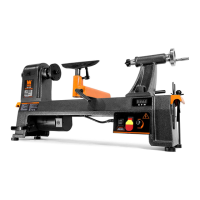20 21
TROUBLESHOOTING GUIDE
20
ERROR CODE PROBLEM SOLUTION
F1
Low voltage protection has
activated.
Check supply voltage and restart lathe.
F2
High voltage protection has
activated.
Check supply voltage and restart lathe.
F3
Operator error - direction changed
while the lathe was ON.
Turn lathe OFF and wait for the display to
show 00, then restart the lathe. ONLY change
directions when the lathe is OFF.
OPERATION
TO SHAPE THE INSIDE OF A BOWL OR PLATE
Turn off the lathe and move the tailstock out of the way. Mount the workpiece onto the face plate and install the face
plate onto the headstock (see "Install The Face Plate" on page 12). Adjust the tool rest in front of the workpiece
to be just below the centerline and at the right angle to the lathe’s turning axis. Rotate the workpiece by hand to
check for proper seating and clearance.
Begin shaping by lightly shearing across the top of the bowl from rim to center. Place a bowl gouge tool on the
tool rest at the center of the workpiece with the flute facing the top of the bowl. The tool handle should be level and
pointed toward the four o’clock position.
Control the cutting edge of the gouge with the left hand, while swinging the tool handle around towards your body
with the right hand. The flute should start out facing the top of the workpiece, rotating it upwards as it moves
deeper into the bowl to maintain a clean and even curve. As the tool goes deeper into the bowl, progressively work
outwards towards the rim of the bowl. It may be necessary to turn the tool rest into the piece as you get deeper
into the bowl.
The variable speed display will show an error code if the lathe has been used incorrectly. Refer to the chart below
to troubleshoot the problem.
Develop the preferred wall thickness at the rim and maintain it as you work deeper into the bowl (once the piece
is thin toward the bottom, you cannot make it thinner at the rim). When the interior is finished, move the tool rest
back to the exterior to re-define the bottom of the bowl. Work the tight area around the face plate or the chuck with
a bowl gouge. Begin the separation with a parting tool, but do not cut all the way through.
NOTE: Try to make one light continuous movement from the rim to the bottom of the bowl to ensure a clean,
sweeping curve through the piece. Should there be a few small ridges left, a light cut with a large domed
scraper can even out the surface.

